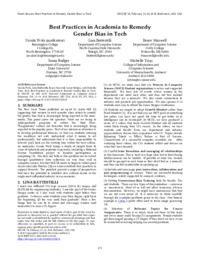Best Practices in Academia to Remedy Gender Bias in Tech Publikationsdatum:
|
 |
 Diese Seite wurde seit 3 Jahren inhaltlich nicht mehr aktualisiert.
Unter Umständen ist sie nicht mehr aktuell.
Diese Seite wurde seit 3 Jahren inhaltlich nicht mehr aktualisiert.
Unter Umständen ist sie nicht mehr aktuell.
 Zusammenfassungen
Zusammenfassungen
The New York Times published an op-ed by Anita Hill [3] suggesting that women in tech consider class action to remedy the gender bias that is increasingly being reported in the mass-media. This panel raises the question "what are we doing in undergraduate programs to reduce the 'Mad Men', 'Brogrammer' culture she describes that is increasingly being reported in the popular press. Part of our mission as educators is to develop professional behavior so that our students entering the workforce not only understand what it means to act professionally, but understand that it is their responsibility to actively push back on the existing bias within the tech culture. As moderator Ursula Wolz brings a depth of insight from 40 years of industrial and academic experience, including a National Science Foundation project to broaden participation in computing [5]. She does not believe this problem can be solved through quantitative data collection on who does well in computer science, but that SIGCSE needs to begin to collect good stories (ala Sally Fincher [2]) on what constitute best practices to support diversity. The panelists present a range of perspectives that have the potential to establish new cultural norms in the single most influential industry in our economy.
 Dieses Konferenz-Paper erwähnt ...
Dieses Konferenz-Paper erwähnt ...
 Personen KB IB clear | Carol Dweck , Paola Medel , Vahab Pournaghshband | |||||||||||||||||||||||||||
 Begriffe KB IB clear |  fixed mindset fixed mindset fixed mindset
, GenderGender
, gender bias
, fixed mindset
, GenderGender
, gender bias
,  growth mindset growth mindset growth mindset
, Informatikcomputer science
, Informatik-Didaktikdidactics of computer science
, Informatik-Unterricht (Fachinformatik)Computer Science Education growth mindset
, Informatikcomputer science
, Informatik-Didaktikdidactics of computer science
, Informatik-Unterricht (Fachinformatik)Computer Science Education
| |||||||||||||||||||||||||||
 Bücher |
| |||||||||||||||||||||||||||
 Texte |
|
 Dieses Konferenz-Paper erwähnt vermutlich nicht ...
Dieses Konferenz-Paper erwähnt vermutlich nicht ... 
 Nicht erwähnte Begriffe | Informatikunterricht in der Schule |
 Tagcloud
Tagcloud
 Zitationsgraph
Zitationsgraph
 Zitationsgraph (Beta-Test mit vis.js)
Zitationsgraph (Beta-Test mit vis.js)
 Anderswo finden
Anderswo finden
 Volltext dieses Dokuments
Volltext dieses Dokuments
 |  Best Practices in Academia to Remedy Gender Bias in Tech: Fulltext at the ACM Digital Library ( Best Practices in Academia to Remedy Gender Bias in Tech: Fulltext at the ACM Digital Library ( : :  , 563 kByte; , 563 kByte;  : :  2020-11-28) 2020-11-28) |
 Anderswo suchen
Anderswo suchen 
 Beat und dieses Konferenz-Paper
Beat und dieses Konferenz-Paper
Beat hat Dieses Konferenz-Paper während seiner Zeit am Institut für Medien und Schule (IMS) ins Biblionetz aufgenommen. Beat besitzt kein physisches, aber ein digitales Exemplar. Eine digitale Version ist auf dem Internet verfügbar (s.o.). Es gibt bisher nur wenige Objekte im Biblionetz, die dieses Werk zitieren.










 Biblionetz-History
Biblionetz-History